Windows Hello is a secure and convenient way to log into your Windows computer. However, we have noticed that sometimes, Windows Hello ceases to work even when the camera is working fine. In this post, we will see what to do when Windows Hello is not working on your Windows 11/10 computer.

Windows Hello not working

If you are facing issues with Windows Hello on your Surface or Windows 11/10 device, simply follow the steps we are going to lay out in this article and everything should end on a high note.
- Set up Trusted Platform Module on your Device
- Enable PIN login via Registry
- Enable Biometrics In Group Policy Editor
- Update Biometric & Imaging drivers
- Run Hardware & Devices troubleshooter
- Reset Fingerprint & Facial recognition options.
Let us see them in detail now.
1] Set up Trusted Platform Module on your Device
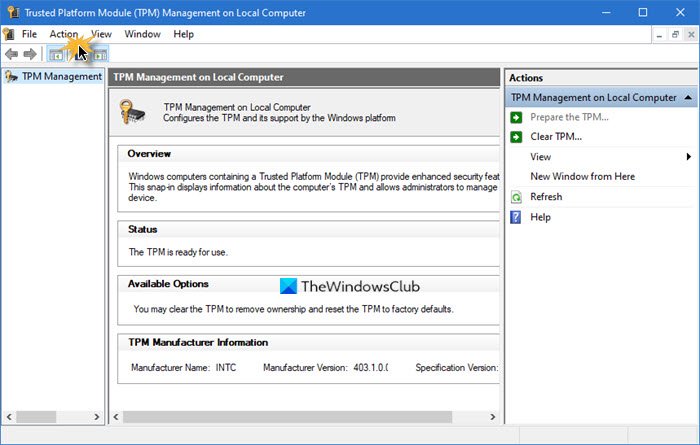
One of the first things you should do is to set up Trusted Platform Module (TPM) on your Windows 11/10 device. You see, this feature provides security that is tightly linked to the hardware; therefore, users must set it up first before any attempts to use Windows Hello.
To activate it, the plan is to open the Run utility by pressing the Windows key + R. From there, please go on ahead and type tpm.msc into the box and hit Enter on the keyboard, or just click the OK button. Doing this should now open the Trusted Platform Module (TPM) Management tool.
You should now see a menu at the top, click on Action then select Prepare the TPM from the menu that pops up.
Once selected, you must then restart the computer and be sure to check if Windows Hello is now working in the correct manner.
Related: Uninstalled Biometric device using Device Manager.
2] Enable PIN login via Registry
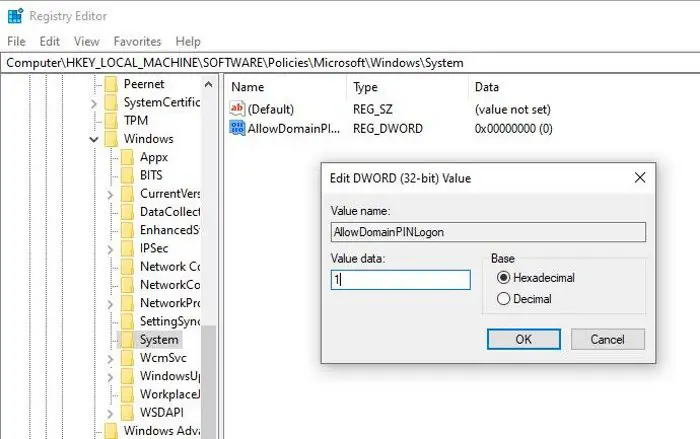
Another option that could fix this problem with Windows Hello, is to permit pin login via the Registry. This is not difficult to accomplish, so let us look at how to get it done.
Open the Run utility by pressing the Windows key + R, then type Regedit in the box, and hit Enter. From there, please navigate to the following section:
HKEY_LOCAL_MACHINE\SOFTWARE\Policies\Microsoft\Windows\System
Select the folder that says System, then try and find AllowDomainPINLogon. If it is not there for whatever reason, then how about right-clicking in the black space, New > DWORD (32-bit) Value. After doing all of that, right-click on the newly created value, then select Modify.
Rename the Value to AllowDomainPINLogon, change the Value data to 1, and then hit OK or the Enter key on the keyboard.
The final step is to restart your computer and check if the Windows Hello issue is still present.
3] Enable Biometrics In Group Policy Editor
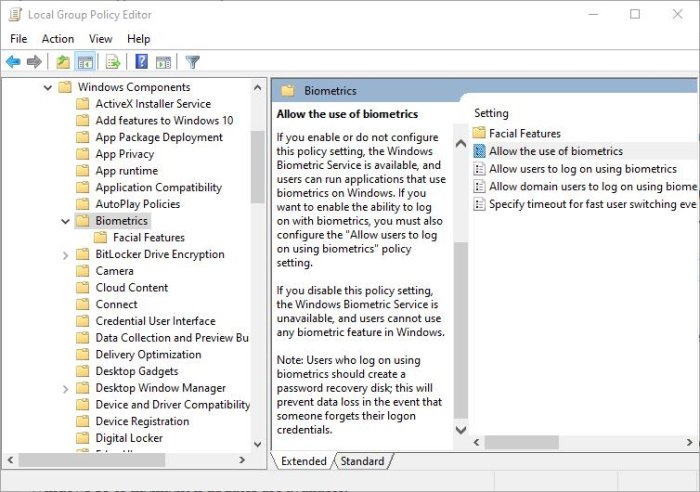
Maybe the reason behind your problems has much to do with the biometrics feature being turned off. We know that when it is not enabled, Windows Hello doesn’t work as intended, therefore, we should go forth and get it up and running from the Group Policy Editor.
Bear in mind that the Group Policy Editor is only available on Windows 11/10 Pro, Windows 11/10 Enterprise, and the Education version.
OK, so to open the Local Group Policy Editor, you must first open the Run dialog box by pressing the Windows key + R, then from there, type gpedit.msc into the open area and complete by hitting the Enter key.
Once the Local Group Policy Editor app is opened, please navigate to:
Computer Configuration > Administrative Templates > Windows Components > Biometrics.
You should now see a setting that says Biometrics. Select it, then double-click on Allow the use of biometrics.
A new window will appear with a few options to play around with. Simply click on Enabled then hit the OK button to complete the task. Finally, restart your computer and then test if Windows Hello is working just fine.
4] Update Biometric & Imaging drivers
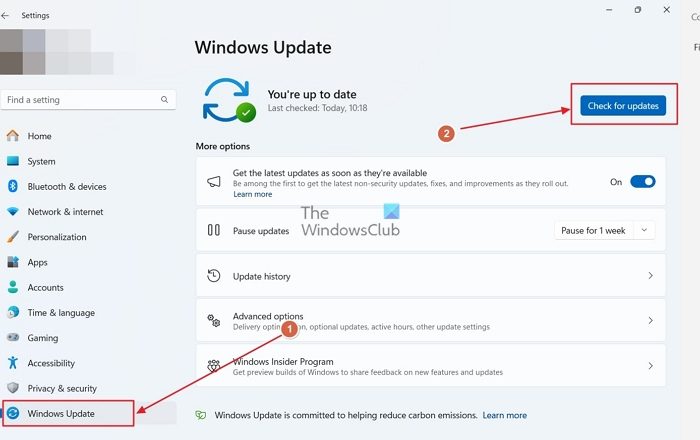
The next key thing to do is to update the Biometric and Imaging drivers.
To check for Windows updates in Windows 11, you can follow the steps mentioned below.
- Open Settings.
- Go to Windows Updates.
- Click on Check for Updates.
In Windows 10, we can do this by opening the Settings app and then going to Update & Security > Windows Update. Finally, click the button that says Check for Updates and wait for your computer to highlight if updates are available.
If not, then we suggest visiting the official driver download website for your Surface computer to find the latest Biometric & Imaging drivers.
5] Run Hardware & Devices troubleshooter
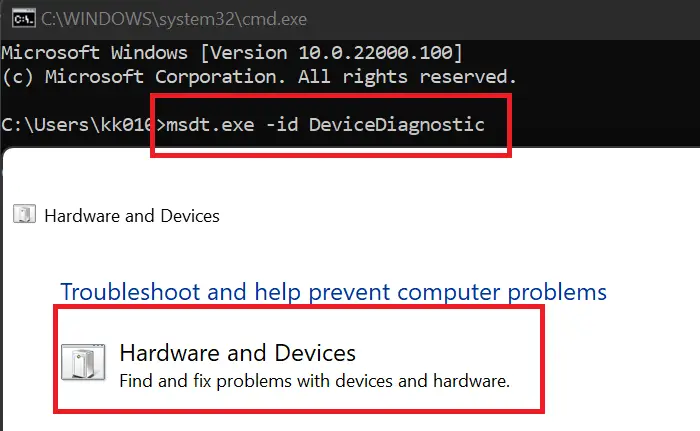
OK, so one of the best ways to solve the Windows Hello issue, is to troubleshoot the hardware and devices.
On Windows 11, open the Command Prompt as an admin and run the following command.
msdt.exe -id DeviceDiagnostic
To get this done on Windows 10, fire up the Settings app once more, then navigate to Update & Security > Troubleshoot. From there, be sure to select Run the troubleshooter and wait for it to finish testing your system for problems.
Alternatively, you can also run the command mentioned earlier.
Hit the Enter key on your keyboard and right away a new window should appear. Click the Next button to run the troubleshooter.
6] Reset Fingerprint & Facial recognition options
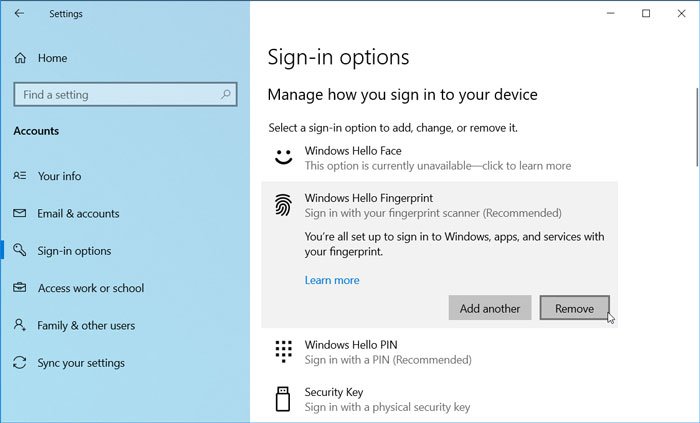
The final tip to fix Windows Hello is to reset fingerprint and facial recognition.
In order to get this done, open the Settings app then Click Accounts and select Sign-In options.
Locate the section that says Fingerprint or Facial Recognition options and click Remove under each.
After that, click Get Started and follow the on-screen instructions to reset Fingerprint and Facial Recognition.
Reboot your device to get things moving in the right direction.
All the best!
Also Read: Windows Hello PIN Remove button greyed out in Windows 11/10.
Leave a Reply